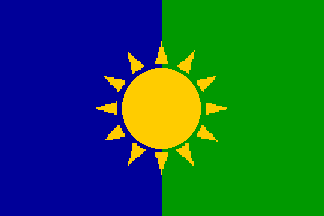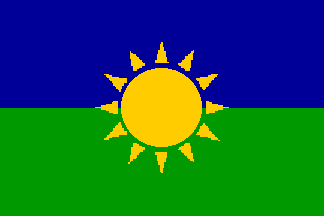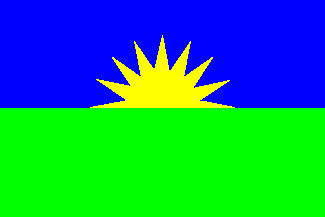



Last modified: 2014-06-29 by bruce berry
Keywords: rwanda | proposal |
Links: FOTW homepage |
search |
disclaimer and copyright |
write us |
mirrors
KIGALI, May 18 1999 (Reuters) - The Rwandan government said on Tuesday it would introduce a new flag, coat of arms and national anthem because the old symbols carried echoes of a 1994 genocide. Officials said the red, yellow and green flag, with a capital R in its centre, was seen as a symbol of the previous Hutu-dominated government whose ideology lay behind the genocide, in which 800,000 Tutsis and moderate Hutus perished. It will be replaced by a red, white and green flag with a new coat of arms in its centre, showing an ear of sorghum, a wreath and a bird.
The old coat of arms, showing a hoe, a bow and arrow and a sickle, carried unfortunate echoes of the crude weapons used to carry out the genocide.
"We judged it necessary to change the national flag, the anthem and the coat of arms to bury the divisive past and foster national unity and reconciliation," Rwanda's Local Government Minister Desire Nyandwi told Reuters.
The Tutsi minority dominated the country before and during the era of Belgian colonial rule, but Hutus held power from independence in 1962 until 1994, when Tutsi rebels took power to end the genocide. The old national anthem celebrated a long Hutu struggle under Tutsi "oppression" while the red in the old flag symbolised the blood of Hutus killed in that struggle. "In public ceremonies... half of Rwandans prefer not to sing the anthem because it is perceived as thrusting the knife into the wounds," one official said.
In the new flag, red will symbolise the blood of all Rwandans, including
those killed in the genocide, white will stand for transparency and justice
and green will represent hoped-for prosperity. The government also intends
to replace street names commemorating Hutu heroes who it says killed Tutsis.
It will also rename Kigali's international airport, which is named after
the country's first Hutu president Gregoire Kayibanda.
Located by Jan Oscar Engene, 19 May 1999
A Reuters report on CNN ran:
Rwanda adopts new flag to bury genocide memories
KIGALI, 1 October 1999 (Reuters) -- Rwanda adopted a new national flag and motto on Friday because the old ones carried echoes of the 1994 genocide. The motto "Unity, Work, Patriotism" replaced "Liberty, Co-operation, Progress" which had been the motto of the central African nation since independence from Belgium in 1962, state-run Radio Rwanda reported. The new flag is mainly blue and green and features a sunrise. It replaces a red, yellow and green flag with a capital R in the centre. The old flag and other national symbols were seen as representing the previous Hutu-dominated government whose ideology lay behind the genocide in which 800,000 Tutsis and moderate Hutus perished. The Tutsi minority dominated the country before and during colonial rule, but after independence Hutus held power until Tutsi rebels overthrew the government to end the genocide in 1994. "It was high time we carried out these changes for not all sections of Rwandans were identifying themselves with the flag... which was a eulogy to the Hutu supremacy," a government official told Reuters.
Source:
http://www.cnn.com/WORLD/africa/9910/01/BC-RWANDA-FLAG.reut/index.html
Web posted at: 10:30 AM EDT (1430 GMT), 1 October 1999
Located by Mark Sensen, 2 Oct 1999.
I just received the following message from Dr. Whitney Smith of the Flag Research Center:
The news report from Reuters about a new national flag having been adopted
by Rwanda on 1 October was incorrect. I checked with my direct sources
in Rwanda who report that the Cabinet on 30 September decided to propose
a flag change. The bill must be drafted, presented to the national assembly,
and passed by a three-quarters vote since it involves an amendment to the
Constitution. It must then be cleared by the Constitutional Court, signed
by the President, and published in the official gazette before Rwanda has
a new flag.
Dave Martucci, 4 Oct 1999
 |
 |
 |
| Dylan Crawfoot | Dylan Crawfoot | Robert Wheelock |
If my memory is correct, the Tutsi Patriotic Front flag is blue over
green while Hutu MDR Party's colour is red, black, green and yellow - namely
the previous colours of the national flag plus black.
Nozomi Kariyasu, 27 Oct 1999
Rwanda has still not settled for a new design to replace its current national flag, it seems. The Africanews web site carried a report from the Nairobi newspaper The East African in which it is reported that the Rwandan government has announced an international competition to find a new flag for the country. As usual, a news report like this much be taken with a few pinches of salt. Anyway, vexillographers should mind the "guidelines", the favoured colours are yellow, green and sky blue, and the designs should feature a rising sun.
Quoting from the website:
"In a notice to bidders for the competition, the Minister for Local government,
Mr. Desire Nyandwi specifically points out that the flag must symbolise
national unity, respect for work, heroism and confidence in the future.
The government wants the flag to have the colours yellow, green and sky
blue in it with the rays of the rising sun shining through."
Jan Oskar Engene, 6 Dec 1999
A piece of news at
this
webpage
We're sorry, say Rwanda genocide leaders
RWANDA'S main political party, which incited Hutus to slaughter their
Tutsi neighbours, has asked for forgiveness for its role in the 1994 genocide.
"The MDR asks for forgiveness from all Rwandans for the divisive campaign
propagated by some of its leaders, which became the basis of the Hutu 'power'
and which led to the 1994 genocide," says the party's new chairman, Pierre
Celestin Rwigema. Rwigema, who held a news conference in the Rwandan capital
of Kigali at the weekend, says they have began reforming the Mouvement
Democratique Republicain (MDR) since the murderers lost power in the tiny
Central African country in 1994.The reform includes the changing of the
party's flag from red-black, which reinforced the Hutu supremacy, into
red-green. "The 'green' epitomises hope for a reconciled and unified Rwanda.
While the 'red' represents the Tutsi and Hutu blood," he explains.
Source: Daily Mail & Guardian
(South Africa), April 15, 1999
So there was [maybe] a flag-change after all... that of the MDR.
Jarig Bakker, 15 Jan 2000
Last week a French minister visited Kigali ; on this occasion TV report
showed that Rwanda still uses its unchanged national flag with black R
in the yellow.
Armand Noel du Payrat, 01 Feb 2000
A week ago I asked Embassy of Rwanda in Tokyo about the new flag. They
say they still use r-y-v with R flag since the government is still in process
to decide new flag. I asked them whether the new flag is somehow blue over
green with sunburst and they were surprised that I know the basic design
which they received as one of proposals from Kigali.
Nozomi Kariyasu, 15 Sep 2000